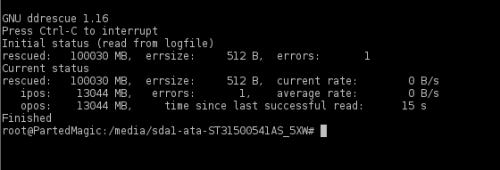
It’s maintained by the GNU project.ĭdrescue copies data from one file or block device to another, trying to rescue the good parts first in case of read errors, scheduling reads inside bad (or slow) areas for later. ddrescue is one of our favorite data recovery tools. The longer it takes to copy your data, the more data is at risk. A drive may degrade with each attempt to access it. When rescuing data from a dying hard drive, time is of the essence. Linux is an excellent operating system to recover data with a wide variety of open source tools designed to clone and recover data from failing drives. For details of all tools in this series, please check the table in the summary section. Anyone who cares about preserving their data should invest a bit of time in learning about this utility.

For this article, we’ll look at ddrescue.
#Ddrescue gui for windows series#
The series examines both graphical and text based open source utilities. These are small, indispensable utilities, useful for system administrators as well as regular users of Linux based systems. Although I hope no one will need to use ddrescue permanently, the GUI is nevertheless a real help.This is the tenth in our series of articles highlighting essential system tools. The GUI sets the important parameters, but not all of them by far. I installed it quickly on my test Ubuntu using these three steps: sudo add-apt-repository ppa:hamishmb/myppaĪs Figure 1 shows, the interface is businesslike and functional. There is also a GUI that you can use to make some quick, useful default settings. In the wake of ddrescue, there is still an armada of other parameters that control the tool's behavior. The command is just the same as before, except you leave out the -n parameter. The second, more time-consuming phase involves using the tool to sort through the faulty blocks and save as much data from them as possible. In the following example, /dev/sdd1 is a partition with read errors on a USB flash drive: sudo ddrescue -n /dev/sdd1 /home/charly/stick.img logfile.log The first phase involves creating an image with all the data that can be accurately read. Two-Speed TransmissionĪdministrators usually use ddrescue in two phases.

Unlike dd, however, it can't be stopped by read errors instead, it stubbornly saves everything that it can get its teeth into. The first two letters subtly indicate a relationship with dd, and ddrescue actually generates a data medium's or partition's image. The tool is included with many popular distributions. (It should not be confused with the even older dd_rescue.) Ddrescue is officially named GNU ddrescue the packages on Debian and derivatives are therefore dubbed gddrescue. The tool is already quite ancient, but its developers look after it untiringly and adapt it to new types of data media. What if really important data is stored on a haywire device that you just can't get rid of? This is where ddrescue comes in. However, I didn't realize that my camera could save to two cards simultaneously – a feature I stupidly didn't use. I do know that memory cards give up the ghost sooner or later. I recently determined that an SDHC card in my camera saves one out of 20 images (on average) as a colorful mess of pixels. However, those undead data media – that trick people into continuing working on them with no idea of the potential impact – are a real pain. Krrr, krrr …! At least things are clear-cut when a hard disk gives up the ghost: You toss the offending disk, get a new one, and put the backup on it.


 0 kommentar(er)
0 kommentar(er)
